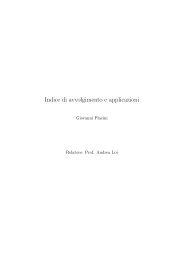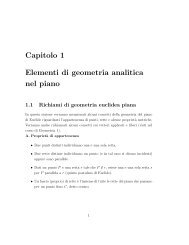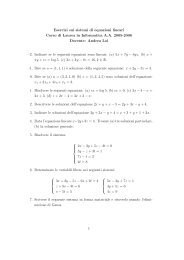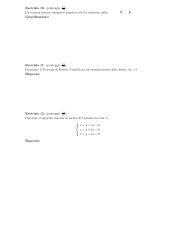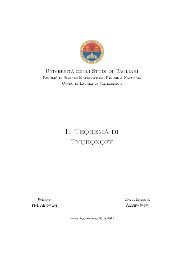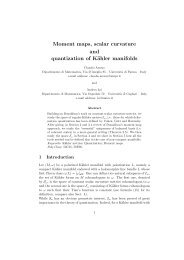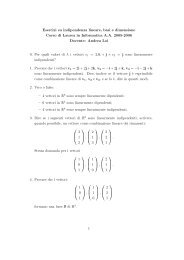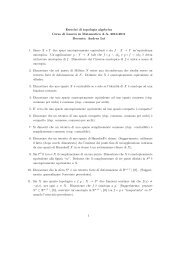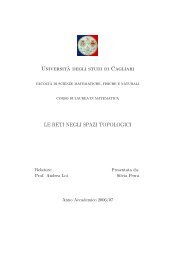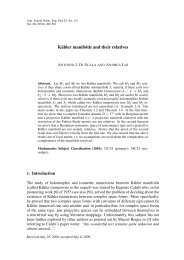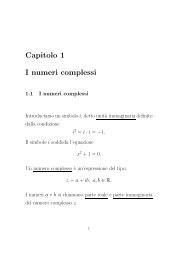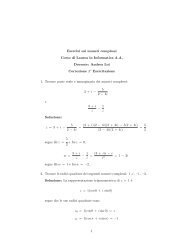Algebre di Lie semisemplici, sistemi di radici e loro classificazione
Algebre di Lie semisemplici, sistemi di radici e loro classificazione
Algebre di Lie semisemplici, sistemi di radici e loro classificazione
You also want an ePaper? Increase the reach of your titles
YUMPU automatically turns print PDFs into web optimized ePapers that Google loves.
3.2. TEOREMA DI ENGEL 31<br />
• a([f, g](b))+([f, g](a))b = a(f(g(b))−g(f(b)))+(f(g(a))−g(f(a)))b = a(f(g(b)))−a(g(f(b)))+<br />
(f(g(a)))b − (g(f(a)))b = a(f(g(b))) + (f(g(a)))b − a(g(f(b))) − (g(f(a)))b<br />
Se pren<strong>di</strong>amo un’algebra <strong>di</strong> <strong>Lie</strong> L su un campo F , allora L è una F -algebra (la forma bilineare<br />
è il commutatore) e risulta definito Der(L) : esso è l’insieme degli endomorosfmi f <strong>di</strong> L tali che<br />
f([x, y]) = [x, f(y)] + [f(x), y]. Fissato un elemento x ∈ L, consideriamo la sua immagine tramite la<br />
rappresentazione aggiunta :<br />
ad x : L → L<br />
y ↦→ [x, y]<br />
Essa è una derivazione <strong>di</strong> L. Infatti prima <strong>di</strong> tutto è un endomorfismo <strong>di</strong> L, ed inoltre, utilizzando<br />
l’identità <strong>di</strong> Jacobi si ha :<br />
ad x([y, z]) = [x, [y, z]] = −[y, [z, x]] − [z, [x, y]] = [y, [x, z]] + [[x, y], z] = [y, ad x(z)] + [ad x(y), z] (3.6)<br />
Una derivazione <strong>di</strong> L <strong>di</strong> questa forma si <strong>di</strong>ce interna ; le altre le <strong>di</strong>ciamo esterne.<br />
3.2 Teorema <strong>di</strong> Engel<br />
Sia L un’algebra <strong>di</strong> <strong>Lie</strong> ed x un suo elemento. Diremo che x è ad-nilpotente se l’endomorismo ad x è<br />
nilpotente.<br />
Se L un’algebra <strong>di</strong> <strong>Lie</strong> nilpotente, ossia L n = 0 per un certo n, allora, per ogni x1, x2, ..., xn, y ∈ L<br />
abbiamo :<br />
ad x1(ad x2(· · · (ad xn(y)) · · · )) = 0 (3.7)<br />
Infatti ad xn(y) = [xn, y] ∈ L 1 , ad xn−1(ad xn(y)) = [xn−1, ad xn(y)] ∈ L 2 e così via fino ad arrivare<br />
all’applicazione <strong>di</strong> ad x1 che restituisce un elemento <strong>di</strong> L n , che deve essere nullo.<br />
In particolare si ha (ad x) n = 0 per ogni elemento x <strong>di</strong> L. Dunque ogni elemento <strong>di</strong> un’algebra <strong>di</strong> <strong>Lie</strong><br />
nilpotente è ad-nilpotente.<br />
Viceversa, se in un’algebra <strong>di</strong> <strong>Lie</strong> L vale la relazione ad x1(ad x2(· · · (ad xn(y)) · · · )) = 0 per ogni scelta<br />
<strong>di</strong> x1, x2, ..., xn, y ∈ L, allora L è nilpotente poichè riusciamo ad ottenere tutti gli elementi <strong>di</strong> L n i<br />
quali risultano nulli.<br />
Ve<strong>di</strong>amo ora il Teorema <strong>di</strong> Engel, il quale <strong>di</strong>ce che se tutti gli elementi <strong>di</strong> un’algebra <strong>di</strong> <strong>Lie</strong> L sono<br />
ad-nilpontenti, allora L è nilpotente.<br />
Per la <strong>di</strong>mostrazione del Teorema <strong>di</strong> Engel ci è necessario premettere due risultati.<br />
Lemma 3.2.1. Dato uno spazio vettoriale V e un suo endomorfismo nilpotente x, ad x è nilpotente.



